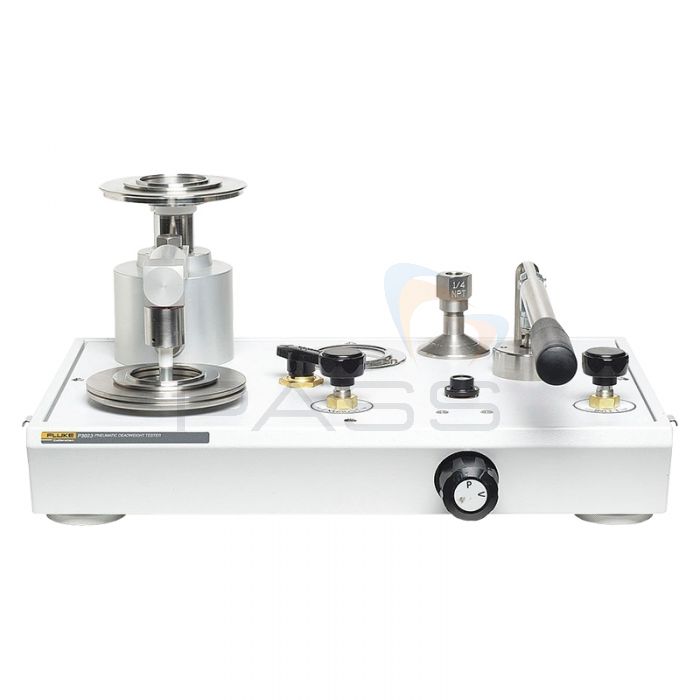Fluke P3023-P Gas Dual Deadweight Tester – With Pump

- Can be used to create pneumatic pressures and vacuums in order to calibrate pressure sensing instruments
- Available in three models
- Built-in hand pump creates pneumatic pressures to 500 psi and vacuums to 90%
The Fluke P3023-P Gas Dual Deadweight Tester – With Pump is able to produce both pneumatic pressures and vacuums. It is therefore suitable for calibrating pressure sensing instruments with ranges within and below atmospheric pressure.
The Fluke P3023-P Gas Dual Deadweight Tester – With Pump is available in three models which vary in terms of their pressure and vacuum ranges, and measurement units. For further information, please see the table below.
| Product Code | Product Name | Pressure Range | Vacuum Range |
| P3023-KPA-P | Fluke P3023-KPA-P Gas Dual Deadweight Tester Vac/Pressure to100 kPa - With Pump | 3 to 200 kPa | 3 to 100 kPa |
| P3023-MBAR-P | Fluke P3023-MBAR-P Gas Dual Deadweight Tester, Vac/Pressure to 1000 mbar - With Pump | 30 to 2000 mbar | 30 to 1000 mbar |
| P3023-INH2O-P | Fluke P3023-INH20-P Gas Dual Deadweight Tester, Vac/Pressure to 400 inH2O - With Pump | 12 to 800 inH2O | 1 to 30 in Hg |
The Fluke P3023-P Gas Dual Deadweight Tester – With Pump can be used to calibrate pressure transducers, transmitters, gauges and pressure switches. As a result of this instrument’s integrated hand pump, it is able to create pneumatic pressures up to 500 psi (35 bar) and vacuums up to 90%. Alternatively, like its sister product, the Fluke P3023 Gas Dual Deadweight Tester – Without Pump, a vacuum pump or external gas supply may be attached to its /NPT female port in order to create vacuums or pneumatic pressures. Like its sister product, the Fluke P3023-P Gas Dual Deadweight Tester includes a high-quality needle which facilitates the user’s ability to make fine pressure or vacuum adjustments.
Other features optimised to improve and maintain the accuracy of this instrument are its adjustable feet and mounted spirit level, both of which ensure that this product can be set-up in a variety of environments without compromising its accuracy. In addition to this, it is supplied with an ISO 17025 accredited calibration certificate and has been calibrated to standard gravity (980.665cm/s²), giving it a standard accuracy of 0.015%. This accuracy can be improved to 0.008% provided particular adjustments are made to the deadweight tester; for instance it may be calibrated to the user’s local gravity, thereby accounting for the effect of this localised gravitational force on the accurately calibrated weight masses.
Adding to this product’s accuracy is its piston and cylinder assembly with floatation indicator. It has been manufactured to the highest standards and therefore includes certified accuracies traceable to international standard laboratories, such as the National Institute of Standards and Technology (NIST). It is designed to limit the effects of distortion and thermal coefficients whilst maintaining the deadweight tester’s stability and durability.
The piston and cylinder assembly will rise as pneumatic pressure is created, to counteract this, accurately calibrated weight masses are added to the piston. Each of these weight masses is marked with both the instrument’s serial number and the nominal pressure value relative to the high- or low-pressure piston; therefore, in order to determine the final pressure, the user need only add these inscribed pressure values together. For further information regarding this process, please see the video below.
Weight masses are constructed from series 3 non-magnetic, austenitic, stainless steel. They may be stored in a robust weight box with a secure locking mechanism, ensuring that they can be transported safely and securely between worksites.
The Fluke P3023-P Gas Dual Deadweight Tester is also supplied with a removable lid which allows the calibrator to be easily transported between worksites. Its test-station design with O-rings and the inclusion of 1/8, 1/4, 3/8, 1/2 NPT and BSP and M20 and M14 metric adapters remove the need for wrenches or PTFE tape when attaching additional instruments. This product is also supplied with spare seals.
The Fluke P3023-P Gas Dual Deadweight Tester – With Pump is an adaptable, versatile, accurate instrument. It is ideal for calibrating a wide variety of pressure sensing instruments, including those with ranges below atmospheric pressure.
Fluke P3023-P Gas Dual Deadweight Tester – With Pump Key Features
- Produce pneumatic pressure and vacuums to calibrate pressure sensing instruments
- Can be used to calibrate instruments with pressure ranges both within and below atmospheric pressure
- Available in three models with varying pressure and vacuum ranges, and measurement units
- Calibrate transducers, transmitters, gauges and pressure switches
- Create up to 500psi (35 bar) of pneumatic pressure and a vacuum to 90% using the integrated hand pump
- Attach an external gas supply or vacuum pump to the /NPT female port
- High-quality needle allows the user to make fine pressure or vacuum adjustments
- Adjustable feet
- Mounted spirit level
- ISO 17025 accredited calibration certificate
- Calibrated to standard gravity (980.665cm/s²)
- Can be calibrated to the user’s local gravity
- Standard accuracy of 0.015% may be improved to 0.008%
- Piston and cylinder assembly with floatation indicator
- Piston and cylinder assembly has been manufactured to the highest standards
- Piston and cylinder assembly has certified accuracies traceable to international standards laboratories, such as NIST
- As pneumatic pressure is created, the assembly is pushed upwards
- Accurately calibrated weights are placed on the piston to counterbalance this force
- Nominal pressure values marked on each of the weight masses added to the piston are combined to determine the final pressure value
- Weight masses are marked with the instrument’s serial number
- The nominal pressure values relative to the high- or low-pressure piston are marked on the weight masses
- Weight masses are made from series 3 non-magnetic, austenitic, stainless steel
- Weight masses may be stored in a robust weight box with a secure locking mechanism
- Tester supplied with a removable lid
- Test-station design with O-rings
- Includes of 1/8, 1/4, 3/8, 1/2 NPT and BSP and M20 and M14 metric adapters
- No need for PTFE tape or wrenches when attaching additional instruments
- Supplied with spare seals
- Adaptable, versatile, accurate pressure and vacuum calibrator
What’s Included?
- Your Choice of Fluke P3023-P Gas Dual Deadweight Tester – With Pump
- Weught Masses
- Removable Lid
- 1/8, 1/4, 3/8, 1/2 NPT and BSP adapters
- M20 and M14 metric adapters
- ISO 17025 Accredited Calibration Certificate
- Spare Seals
Offers
 Spend £150+ (Ex VAT) on any qualified Fluke or Beha-Amprobe product(s) and claim a free tool of your choice from the list at Fluke Promotion. Valid February 17 2025 - July 31 2025.
Spend £150+ (Ex VAT) on any qualified Fluke or Beha-Amprobe product(s) and claim a free tool of your choice from the list at Fluke Promotion. Valid February 17 2025 - July 31 2025.
Claims are made direct to Fluke. Terms and conditions apply.
Fluke P3023-P Gas Dual Deadweight Tester – With Pump Technical Specifications
| Accuracy | |
| Accuracy | ±0.015% of reading (±0.008% optional)
*Accuracy based on % of reading from 10% to 100% of the piston range when used in accordance with the corrections found on the calibration certificate. Below 10% ± (accuracy class) x 10% of the piston range. |
| Mass and PCU Materials of Construction | |
| Standard weight material | Series 3 non-magnetic austenitic stainless steel |
| Weight density | 7.8 g/cm³ |
| Optional fractional weights | Solution heat treated aluminium |
| Weight density | 2.7 g/cm³ |
| Piston Material | Ceramic |
| Cylinder Material | Martensitic steel |
| Coefficient of Expansion | 11 ppm/°C |
| General | |
| Test port adaptors | 1/8, 1/4, 3/8 and ½ NPT or BSP |
| Instrument weight | 24 lbs |
| Instrument size | 17.5 W x 12 D x 8.5 H |
| Mass set weight (typical) | 65 lbs |
| Minimum Standard weight Increments - Pressure | 2 inH2O, (10 mbar) |
| Minimum Standard weight Increments - Vacuum | 0.2 inHg (10 mbar) |
| Built-in Hand Pumps | |
| Pressure mode | Max pressure 300 psi (20 bar) |
| Vacuum mode | To 90% vacuum |




